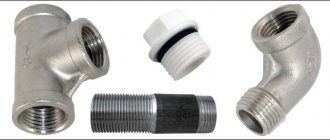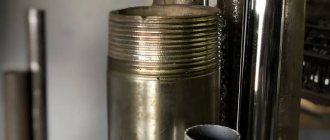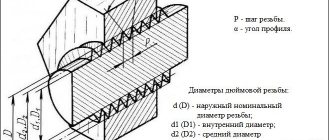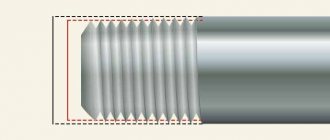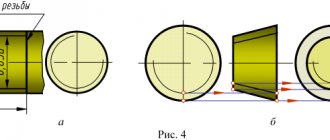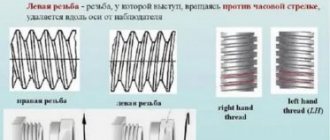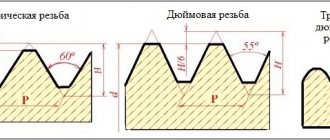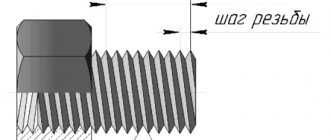Pipe bends are a connecting fitting made in the form of a section of pipe with threads at the ends. For ease of installation, the threads on the squeegee vary in length and size. Squeegees can be used in the construction of water pipelines, gas pipelines, heating and sewer systems. How to independently select the most optimal device for a particular situation and install it, read on.
Connection fitting for pipeline
Specifications
The squeegee looks like a piece of pipe with threads on both sides. The segment must be straight or angular. On the short side, the thread consists of 5 turns, and on the long side, it consists of 20 turns or more, up to 30. The short end of the thread is connected to the pipe of the equipment, for example, a gas boiler or battery, and the long end is connected to another pipe. A coupling of a selected size with a lock nut also “goes” along the long thread.
The bends are made of metal, often “reinforced” with a zinc coating. If you require a decent appearance of pipes, it is possible to purchase elements with nickel plating. Often two numbers are indicated on the marking of the run, for example, 75/76. This says that the outer diameter of the product is 76 millimeters and the inner diameter is 75 millimeters.
The parameters (the length of the threads, its diameter and the size of the thread in inches) must be observed in accordance with GOST and correspond to the dimensions of the installed pipeline, for example, 25 millimeters (1 inch). The maximum diameter of the drive is 50 millimeters, the minimum is 15 millimeters. If the diameter of the pipeline itself is larger, then the solution to the problem is achieved through the use of flanges.
The maximum length of the fitting is 160 millimeters (for a diameter of 50 mm), and the minimum is 110 millimeters (for a diameter of 15 mm). These indicators can again be found in GOST. However, in practice, reality often does not meet the standards, so it is better to measure everything yourself and buy parts of the required length.
There is a classification of surges depending on the scope of their application: short, long and compensating. The latter are used for plumbing fixtures, batteries and other devices in order to minimize deviations within 5 centimeters detected during installation. The length of short runs is from 10 to 15 centimeters, and long ones are about 30 centimeters. The length of the compensating slopes varies from 13 to 17 centimeters.
The long thread of the short type is from 5 to 9 centimeters, and the short thread is from 9 to 17 millimeters. In general, the dimensions of the short side are the same for all types of bends. The long side of long bends also varies from 5 to 9 centimeters. The long side of the compensating surges ranges from 7.5 to 10 centimeters.
The main advantages of using squeegees include:
- simple installation without a welding machine;
- no need to invite a specialist;
- the appearance of a special unit that simplifies disassembly in case of need for repair, cleaning or replacement.
Among the disadvantages is the likelihood of a leak due to a lack of tightness.
Types of pipe threads and areas of application of individual types
Pipe threads can be classified according to several indicators:
Certain types of pipe threads and their features
To connect pipes to a water supply system, heating system, etc., you can use the following types of threads:
- cylindrical. It is used for the construction of pipelines of various types for domestic and industrial purposes;
- canonical. Mainly used in the construction of pipelines carrying liquid or gas that are under high pressure. This thread allows for a more tight connection;
- inch.
Inch threads have hardly been used lately. For this reason, we will consider in more detail the cylindrical and canonical types of thread.
Cylindrical thread (indicated in the diagrams by the letter G) is manufactured in accordance with GOST 6357-81 and has the shape of an isosceles triangle with an angle of 55º at the apex.
Drawing of cylindrical thread in accordance with GOST
The main parameters are:
- external, internal and average thread diameters (d, d1 and d2, respectively);
- outer, inner and middle diameters of the coupling (D, D1 and D2);
- thread pitch (P);
- height of the triangle and working profile (H and H1);
- radius of curvature (R).
Straight threads are cut on pipes with diameters ranging from 1/16 inch (7.723 mm) to 6 inches (163.86 mm). The main pipe dimensions are shown in the table:
Typical cylindrical thread sizes
Additional parameters regulated by GOST are:
- accuracy class. The thread can be made with accuracy class A (more accurate) and B (less accurate);
- make-up length. Two parameter values are set: N – normal length and L – long length.
Thread make-up length according to GOST
All considered parameters of cylindrical threads are indicated in the markings.
For example, G1/2-A-40. This means that the cylindrical thread (G) has the following parameters:
- diameter ½ inch;
- accuracy class A;
- make-up length L 40 mm. The normal make-up length (N) is not indicated in the markings.
Canonical thread (marked with the letter R) is manufactured according to GOST 6211-81. Main distinctive features:
- triangle apex angle 55º;
- taper 1:16.
The diameter of pipes on which tapered threads can be cut ranges from 1/6 inch to 6 inches, which corresponds to 7.723 - 163.83 mm.
The table shows all typical conical thread sizes:
Dimensions of produced conical threads on pipes
The marking of tapered threads indicates the following parameters:
- type: internal (Rc) or external (R);
- diameter (in inches).
For example, R1/2 means the male taper thread is ½ inch in diameter.
Pipe thread parameters
Additional technical parameters of pipe threads are:
- units;
- direction.
Pipe threads can be measured:
- in inches (inch thread);
- in millimeters (metric thread).
The main difference between a metric thread and an inch thread is the triangle angle observed when cutting the thread. If on an inch thread the angle is 55º, then when cutting a metric thread the angle increases to 60º.
Basic parameters of metric thread
For the construction of pipelines for domestic purposes (heating systems, water supply or gas supply, drainage, and so on), inch threads are used. Metric (more accurate) threads are mainly used in the construction of pipelines subject to vibration, as well as heavy structures.
Read also: Service life of a flexible gas hose
The direction of rotation of the profile is also essential when determining the thread. According to this indicator, pipe threads are divided into the following types:
Left-hand threads are applied exclusively to pipes, provided that the main load acting on the connection is directed in the direction of unscrewing the connecting element. In other situations, a right-hand thread is used.
Dimensions of bends according to GOST
The diameter of the steel pipes exactly matches the dimensions of the pipeline being installed. The weight of steel bends depends on their length. The sizes are standardized and shown in the table below.
| Conditional bore, mm | Thread type | Outer diameter, inch | Length of the short part, mm | Length of the long part, mm | Total length, mm | Weight, g |
| 10 | Pipe | ¼ | 8 | 40 | 90 | 62 |
| 15 | Pipe | ½ | 9 | 42 | 110 | 94 |
| 20 | Pipe | ¾ | 10,5 | 45 | 120 | 134 |
| 25 | Pipe | 1 | 11 | 50 | 130 | 243 |
| 32 | Pipe | 1 ¼ | 13 | 55 | 140 | 336 |
| 40 | Pipe | 1 ½ | 15 | 60 | 150 | 463 |
| 50 | Pipe | 2 | 17 | 65 | 160 | 608 |
At the customer's request, the bends can be manufactured with a nominal bore of 65 and 80 mm.
Types of pipes for production
Pipes used in water supply systems, heating systems, and gas pipelines are called water-gas pipelines (WGP). The use of VGP steel pipes with different wall thicknesses is determined by operating conditions. The following types of products are distinguished:
The weight of the products depends on the type of pipe used. For production, steel pipes GOST 3262-2010 are used.
| Outer diameter, inch | Pipe wall depending on the type of flow, mm | Weight depending on the type of drive, kg | ||||
| lungs | ordinary | reinforced | lungs | ordinary | Reinforced | |
| ¼ | 2 | 2,2 | 2,8 | 0,132 | 0,143 | 0,175 |
| ½ | 21,3 | 2,5 | 2,8 | 0,207 | 0,229 | 0,256 |
| ¾ | 2,5 | 2,8 | 3,2 | 0,268 | 0,297 | 0,333 |
| 1 | 2,8 | 3,2 | 4 | 0,379 | 0,428 | 0,521 |
| 1 ¼ | 2,8 | 3,2 | 4 | 0,489 | 0,553 | 0,677 |
| 1 ½ | 3 | 3,5 | 4 | 0,596 | 0,688 | 0,777 |
| 2 | 3 | 3,5 | 4,5 | 0,762 | 0,874 | 1,103 |
Correct installation of the American
American plumbing is installed using adjustable, open-end and universal wrenches. Also, sometimes you may need a special round key, which American women use to tighten them from the inside. The use of gas keys is prohibited. Excessive force applied to the handles of the gas wrench can deform the union nut.
Let's look at how to install an American pipe onto a pipe.
An American with internal thread is installed on two sections of the existing pipeline. If there is no thread on the pipe, then it is cut using a die. A sealant is wound onto the threads of one section. This can be FUM tape, flax fibers or other materials. After this, one part of the American is screwed onto the pipe using a wrench. Then a sealant is applied to the second threaded section, after which the second American fitting with a nut is screwed onto it. After which the two sections of the pipeline are connected to each other by tightening the union nut of the fitting.
Installation of an American with external thread is carried out almost the same way. The difference is that the seal is screwed onto the American thread itself.
As you can see, the use of American-type connecting elements can significantly speed up and simplify the process of installation and possible dismantling of pipelines and other plumbing fixtures.
Existing thread cutting methods
Threading a pipe is done using several methods:
- taps (for internal threads) and dies (for external threads). This method of application is most often used when independently constructing a household pipeline;
Using a Pipe Thread Die
How to cut threads on a pipe yourself, watch the video.
- knurling. This method is used for threading water and gas pipes with a diameter from 10 mm to 65 mm. The resulting thread is highly accurate;
Threading by rolling method
- cutters on special machines. This technique allows you to apply threads to pipes of any diameter. The carving is quite accurate.
Technique for cutting threads on a lathe
These pipe cutting methods can be used in the construction of water supply, gas, heating and sewer systems for both domestic and industrial purposes.
When installing pipelines of various functionality, auxiliary parts are used for joining, branching and flow regulation. Among the list of these elements, fittings play an important role. These also include pipe bends. These blanks are well known to plumbing professionals due to their ease of use. But, like other parts, they have their own technical characteristics and conditions of use.
A squeegee is a connecting part used in the installation of pipelines
Features of the American fitting
The American for plumbing is a collapsible design, a combined coupling of two threaded fittings and a union nut.
It can be flat and when used, the tightness of the connection is ensured by the gasket. The product is compact and affordable. During operation, it may be necessary to tighten the nut and replace a worn-out gasket, so it is not advisable to make such a connection hidden.
There is another version of the element - American cone. In this case, a gasket is not needed, since the polished parts of the cone-shaped fittings fit together as closely as possible during the process of tightening the nut.
The deviation along the axis of the pipes being laid should not exceed 5 degrees. They must be carefully checked for hidden defects. When creating critical connections that will operate under conditions of temperature differences in devices such as, for example, a water heater, you should use the cone version.
Thanks to the American, they are switching to a pipe that has a different diameter or is made of a different material. With its help you can make an angular type of connection.
The ease of use of this part has led to a number of plumbing manufacturing companies using it as a mounting product for metering devices, branded faucets, filters and other products.
To make an American fitting, you can use the following materials:
- cast iron;
- stainless steel;
- brass with nickel or chrome plated;
- metal-plastic.
In the latter case, a combination of polypropylene and stainless steel is used - such products are used when installing plastic risers.
Depending on the presence of external or internal threads, the following types of American threads are distinguished:
- coupling coupling;
- thread coupling;
- thread-thread.
American-type connections are produced for all popular sizes of pipe products. The most popular parameters are 1/2 and 3/4 inches.
Any sizes to order
steel barrels from us
.
The nomenclature list is very extensive. First of all, the sizes available to the consumer are 1 inch, 1/2, 3/4
. We make all other sizes to order in the shortest possible time. Our resources allow us to accept orders for large volumes. If you are interested in retail, we are also happy to offer high-quality components at low prices. Our price will please you, as will the quality of the products we produce.
Type
Installation of squeegees
Connection with plastic pipes
Connecting plumbing components using plumbing fittings is considered simple: installing the element does not require special skills or practice.
Elements for water are fundamentally different in that the threads in them are located on the outside, and they must be covered with an anti-corrosion layer. This type of connection is considered detachable: it will be appropriate in the event that in the future there may be a need to disassemble part of the pipeline.
The drive, coupling and locknut assembly must be connected tightly and efficiently so that leaks do not occur in the future and tightness is ensured.
Installation of connecting elements for pipes and general assembly of the water supply system is carried out in several stages:
- A coupling is screwed onto one of the edges of the pipe.
- A drive is attached to the coupling. You need to screw in the part to the maximum. The side with the shorter thread should be used.
- A locknut is screwed to the opposite side. A connecting fitting is fixed to it, which is usually used in places where the diameter of the pipes is different, or where the pipe branches.
- The end of the drive is adjusted to the pipe, after which the coupling is screwed together, which should go onto the pipe.
- At the end of the work, the locknut is tightened to the coupling so that they are separated from each other at a distance not exceeding three centimeters. To secure, fill this free space with a sealant, for example, plumbing tow with grease or paste.
If you need to dismantle the installed section of the pipe, you should first unscrew the nut, then the coupling, and finally remove the bend.
Pipeline assembly technology
To assemble the pipeline, you must perform the following sequence of actions:
- First, screw the coupling onto the pipe.
- Then the side with the short thread is screwed into the coupling (sometimes it is connected directly). The parts should be screwed all the way, then the connection will be reliable.
- A locknut is screwed onto the long side of the drive.
- Next comes the connecting fitting.
- Then the end of the drive is applied to the pipe and the coupling is screwed together so that it goes onto the pipe. The connection will be easier to complete if the axes of the parts coincide as much as possible.
- The fitting must then be secured with a locknut. To do this, it should be screwed to the coupling so that there is a distance of 2-3 cm between the parts. This space must be filled with strands of flax. They should be wound in the direction of rotation of the nut. Then the locknut should be tightened until it stops. This must be done to seal the connection and prevent water leakage through it. You should use a wrench to tighten the locknut because its edges are narrow.
Connection device with squeegee
Connecting a pipeline using a product involves using a coupling (one or two) and a lock nut in the design. The end at which the short-length thread is screwed into a faucet or other device. Then the locknut and coupling are screwed onto it. Then the coupling is screwed onto the pipeline; the nut prevents the coupling from unscrewing. The price of such a kit depends on the material.
The cheapest are cast iron and steel products. They have a certificate of conformity, like imported products.
To seal joints, the following are used: for threads - flax, sealant, fum tape, on the outside - varnish or paint with a short drying time. Reversing the thread causes leakage at the joint with a high probability. To hold the valve in the desired position, use two keys.
The problem area in the design is considered to be loose threads. The wall on the pipe remains thin and quickly corrodes. It needs to be galvanized. In order to galvanize, a special composition is applied, from which zinc is deposited on the surface of the metal. After which the steel becomes protected.
Recommendations for use
To extend the service life of any pipeline part, it must be painted regularly. This reduces the likelihood of rust on the metal pipe. However, if it becomes necessary to disassemble the painted area, the paint layer must first be removed from the squeegees. This can be done using an ordinary knife or a blowtorch.
If rust still appears even with an anti-corrosion coating, this problem can be most easily solved by replacing the hose made of stainless material. Brass elements last a long time and do not rust.
Another common problem is the locknut leaking. This situation occurs regardless of how correctly the parts were selected. The reason for this is most often simple: the seal has become unusable.
Linen thread winding tends to burn out or rot. In this case, the old seal should be replaced. It is advisable to treat new linen thread with a special quick-drying varnish before winding. This coating will create a protective layer that prevents overheating or getting wet.
If the pipe bend is selected the right size and is made of high-quality material suitable for a specific pipeline and operating conditions, it will last a long time and will not cause problems during use. By choosing the best option, you can save yourself from possible problems.
To put it briefly, what a squeegee is is a small piece of pipe with threads cut at both ends. The threads are cut to different lengths for ease of disassembly during operation, if necessary.
The length of the thread on the product depends on the diameter. The smaller the diameter of the product, the greater the coefficient that determines the length. The minimum values are as follows: short thread of at least 5 threads, long thread of at least 20 threads.
All products are GOST certified and the definition is as follows. A squeegee is a connecting part with a cylindrical thread intended for pipelines. Regulatory document number – 8969-2010. installed on water supply systems, heating systems, gas pipelines and others that operate with non-aggressive media, such as water, steam, gas, at temperatures up to 175°C and pressure not exceeding 1.6 MPa.
Steel products can be classified as follows:
Thread-cutting products, Steel fittings
CONNECTING PARTS WITH CYLINDRICAL THREAD FOR PIPELINES P = 1.6 MPa, GOST 8965-75
Steel fittings , connecting parts with cylindrical thread - used for connecting pipes in heating systems, water supply, gas pipelines and other systems operating in non-aggressive environments (water , saturated water vapor, flammable gas, etc.) at a temperature of the conducting medium not higher than 175 °C and a pressure P = 1.6 MPa. Steel fittings - used for direct connection of pipes, the main connecting part is a steel fitting with threads on both sides, short and long. Assembled squeegee : the squeegee is attached to the pipe from the short thread side; a coupling and lock nut ; this design provides the most durable and reliable connection. To seal the connection, it is allowed to use sealing material.
Steel barrels made from GOST 3262-75 pipes are intended for connecting steel pipes in water supply, gas, heating systems, etc. Material (main): steel. Connection type: thread. Working medium: Water, steam, gas. DN : 15, 20, 25, 32, 40, 50. Thread: 1/2”, 3/4”,1”, 1.1/4”, 1 1/2”, 2”. Working pressure: PN (kgf/cm2) : 16. Working medium temperature (highest): 175°C.
Steel locknut GOST 8968-75 - used in pipeline systems for water, steam, non-aggressive liquids, gas. Material (main): steel. Connection type: thread. Working medium: Water, steam, gas. DN : 15, 20, 25, 32, 40, 50, (65), (80), (100). Thread: 1/2”, 3/4”,1”, 1.1/4”, 1 1/2”, 2”. Working pressure: PN (kgf/cm2) : 16. Working medium temperature (highest): 175°C.
Straight steel coupling GOST 8966-75 - used when laying a pipeline to connect two pipes into one system. Metal: steel. Working medium : water, steam, gas. DN : 15, 20, 25, 32, 40, 50, (65), (80), (100). Connection type: thread. Thread: 1/2”, 3/4”,1”, 1.1/4”, 1 1/2”, 2”, 2.5”, 3”, 4”. Design features: straight. Working pressure: PN (kgf/cm2) : 16. Working medium temperature (highest): 175°C.
Steel thread GOST 6357-81 is a connecting element in pipeline systems, gas pipelines, heating systems, as well as for the installation of pipeline fittings. Metal: steel, from pipe according to GOST 3262-75. Working medium : water, steam, gas. Du : 8, 10, 15, 20, 25, 32, 40, 50, (65), (80), (100). Connection type: thread. Thread: 1/2”, 3/4”,1”, 1.1/4”, 1 1/2”, 2”, 2.5”, 3”., 4”. Pressure: PN (kgf/cm2): 16. Working medium temperature: °C: +175.
Steel squeegee GOST 8969-75 is a fastening element consisting of a pipe with threads at both ends. On one side the thread is longer, on the other it is short. At the end with a long thread, a coupling and a locknut are mounted; the thread on the other side is used to secure the outlet to the pipe. Steel clamp is used to firmly connect water supply parts. Metal: steel, from pipe according to GOST 3262-75. Working medium: water, steam, gas. Du : 15, 20, 25, 32, 40, 50, (65), (80). Thread: 1/2”, 3/4”,1”, 1.1/4”, 1 1/2”, 2”, 2.5”, 3”., 4”. Connection type: thread. Working pressure PN (kgf/cm2): 16. Working temperature: °C: +175.
Fittings for connecting metal pipes are an incredibly important part in the installation of pipelines. Fittings allow you to connect branches, turns, pipes of different diameters, and are indispensable when intensive assembly and disassembly of pipes is necessary. To ensure efficient connection of pipes and accessibility for maintenance, it is necessary to buy steel fittings.
Steel fittings become widespread due to their simplicity of design. Their main detail is the squeegees . When installing, it is attached to the short thread to the pipe, and a lock nut and couplings . purchase steel fittings in a specialized store.
Steel fittings can be operated over a wide temperature range and withstand high pressure. Despite the high technical characteristics, the prices for steel fittings are the most affordable. If you need to install pipes for heating, gas or water supply systems, you need to buy steel fittings . of fittings is quite low, which makes them affordable.
Buying steel fittings today is easy - today there is a huge selection of similar high-quality products at low prices.
Source
Application benefits
The main positive aspects from using squeegees are:
- A design made in this way allows the joining of pipeline components to be carried out quite simply and at the same time very reliably.
- The contact of the parts is dismountable, and this greatly simplifies the process of cleaning pipes and repair work to replace the failed section.
- For installation there is no need to use special equipment or invite specialists. The whole process can be done with your own hands (read about the rules for the technical operation of water supply and sanitation systems here). The main thing is to follow the installation recommendations and the sequence of your actions.
As for the shortcomings, I would like to say the following:
If the locknut is handled improperly, a leak may occur.
But this is not a “minus” of the product itself, but most likely of the installation.
Therefore, a flaw of this kind is a consequence of inept handling of mechanisms.
When choosing products, you need to understand the designations.
Previously, manufacturers applied markings in inches.
At the moment, the metric system is increasingly used.
When choosing, you need to pay attention to the price of the products. This parameter will directly affect the cost of the work as a whole.
If desired, you can purchase devices complete with other elements (couplings, nuts).
Methods for connecting pipelines to the outlet
Plumbing fittings differ from other pipe blanks in that they have threads applied on the outside. This is very convenient in operation, for example, when installing a ball valve with a squeegee. However, in large-diameter pipelines, installation on flanges is preferable, especially when it is necessary to make a collapsible joint. On the run-out, tow is wound between the coupling and the nut to finally secure the joint.
The standard connection method when installing a valve or ball valve involves the use of a spigot with a coupling and lock nut and a short thread on the other side for connection to the pipe. As a sealant, use plumbing tow, lubricated with grease, or a special paste. The prepared base is aligned at the ends by turning the coupling.
Sometimes it is necessary to dismantle part of the pipeline to remove rust and other blockages from the system. Then the steel pipes with the coupling and locknut are disassembled and the problem is eliminated. It is better to replace a worn-out part with a new one, without waiting for leaks and other complications. The block is removed with a lever wrench.
In open sections of the pipeline in an apartment or private house, for aesthetics, it is recommended to use a product with anti-corrosion protection. That is, not an ordinary plumbing fitting, but a nickel-plated one
To ensure tightness, it is important that the workpieces and pipes align exactly along the same axis
What is a drive, thread, barrel, nipple, how do they differ?
All of the above parts are used for splicing metal pipelines associated with hot and cold water supply systems of residential buildings and their heating.
When installing these systems, their maintenance is provided without the use of open flame (welding, cutting, etc.).
The use of these parts makes it possible to disassemble and reassemble systems independently.
“A part intended for threaded connections of pipelines. It is a piece of pipe with pipe threads at the ends. At one end the thread is short (5-6 threads), at the other it is long (20.30 threads). Squeegee is most often used to connect two fixed pipelines. "
The length of the pipe section itself may vary and differ from the standard one (sold in the store).
The name - “Drive” is derived from the fact that, when splicing pipes, the coupling (in the photo is located on the right side of the pipe and is cast from cast iron), first, is twisted back (driven) and placed close to another thread (usually wrapped in tow). ), and then screwed onto the pipe being connected.
In addition to the coupling, the kit includes a lock nut that presses against the coupling and compresses the flax tow, preventing liquid leakage. Acts as a sealant.
“Scope of application: to create threaded detachable connections of pipeline systems at a temperature of the conducting medium not higher than 175 ° C and pressure P = 1.6 MPa. "
Sold without coupling and locknut.
The main function in the system is
» In the case of a permanent connection of pipelines, the nipple can simultaneously perform the function of their mechanical (power) fastening. In particular, a plumbing radiator nipple is used to connect sections of heating radiators to each other and is made simultaneously with left and right threads, which allows, by rotating it with a special nipple wrench, to tighten both parts together at the same time.”
What it is?
Let's find out what American plumbing is and on what principle it works.
An American is a connecting element designed for quick and convenient joining of pipelines made of various materials with internal or external threads. The product structurally consists of the following components:
- quick release threaded hex nut;
- 2 fittings, also threaded;
- rubber, polyurethane or paronite gasket (in some models, in particular conical ones, this may not be present).
Essentially, this is a coupling that has a collar and a union nut that rests against this collar. The American coupling pipe connection allows you to connect two sections of pipeline by rotating just one nut. The connection can be disassembled in the same way.
The photo shows the components of the American
Connectors are made from stainless steel, brass alloys, cast iron, combinations of stainless steel and polypropylene. The products are able to withstand working environment temperatures up to +120 degrees. The permissible pressure is usually indicated on the product body.
The outer surface of the American steel has a decorative nickel coating, which protects the product from corrosion and mechanical damage, and also provides aesthetic appeal. If you use too rough tools to work with American steel, scratches may appear on the surface of the product.
Advantages and disadvantages of connecting pipes on pipes
The main advantages of connecting a fixed pipeline with a thread:
- During installation it is easy to do without special equipment (welding machine):
- no qualifications as a welder or extensive experience in pipeline installation are required;
- It is enough to follow the technology and recommendations for joining pipe blanks;
- without welding, reliable joining of pipes is obtained;
- After work, a collapsible block remains, which simplifies the future repair of this section of the pipeline.
Among the disadvantages, experts note the likelihood of a leak if the connection is not sealed using a lock nut.
When choosing a part, its length is of significant importance
Types of surges
- Nickel plated.
Thanks to the galvanic coating with a layer of nickel, they have an attractive appearance and for this reason they are used for the installation of heating pipes, water supply and gas pipelines. Such fittings are much more expensive than their analogues. - Galvanized.
Designed for mating pipes in systems operating in non-aggressive environments. Galvanized pipes, complete with coupling and locknut, are used not only when laying pipelines and installing heating systems, but also when installing valves, drain valves, metering and control devices. - Steel. They are made from:
- ordinary,
- stainless steel (about high-quality water heated towel rails is written on this page).
galvanized,
The rods are galvanized for one purpose - to increase the resistance of the part to the rusting process. And this helps to extend the service life of the threaded connection.
These devices are used on pipelines that are laid in the ground and where the working medium is steam, water and gas.
To protect parts from corrosion, they are coated with a special compound. In addition to steel, copper, cast iron and bronze can be used as materials.
The material and design of the product can affect the chemical composition and temperature of the operating environment.
By using moldings from various variable materials, it is possible to achieve predetermined properties (for example, rust resistance).
For example, copper parts practically do not respond to changes in temperature and exposure to ultraviolet rays.
Stainless steel connectors last the longest, three times longer than carbon steel parts and twice as long as galvanized steel ones.
GOST drives:
- product length - 110, 130, 150 mm,
- internal diameter – 15, 32, 50 mm,
- distance of the long section with grooves - 40, 55, 65 mm,
- the distance of the short threaded section is 9, 13, 17 mm.
In addition to the above dimensions, there may also be intermediate parameters.
Remember! Connecting parts must be selected only in strict accordance with the diameter of the pipes.
Conventionally, all surges can be divided into the following types:
- Short
- Long.
- Compensating.
Compensating bends with long grooves are used when connecting pipes to plumbing fixtures or heating radiators (which radiators are best for an apartment) in order to eliminate deviations in the length of the liner, which may have been allowed during production.
Purpose
The method of connecting pipeline elements depends on several factors, for example, the material of the pipes, the type of transported substance, as well as the conditions of the working environment. The main purpose of pipe fittings is to connect them to plumbing or gas appliances. Welding is not suitable here, because the connection must be detachable: if necessary, some element may have to be dismantled. For example, it is recommended to use squeegees in heating networks after the valve on the riser.
In the event of a breakdown, the presence of a squeegee will make it easy to get the shut-off valve element to repair or replace it. Squeegees are also useful for old cast iron radiators; their presence will help clean the pipeline. This element is used to connect various heating equipment: tanks and gas boilers, as well as mixers. In the kitchen, the squeegee is useful when connecting the stove. Finally, it can be used to create an additional pipeline branch.
Is it possible to make a squeegee yourself and how to do it?
When installing a pipeline with your own hands, sometimes a situation arises when you need to select the required length of pipes - factory products, according to standards, cover only a narrow range of sizes and diameters. In this case, a self-made pipe is used, and the clamping locknut and coupling of the required diameter are taken from another workpiece. For manufacturing, you need to use a piece of gas pipe of suitable length; to carry out the work, you will need a die with a holder or clamp, oil, a vice for clamping the workpiece, a hacksaw for metal or a grinder for cutting the pipe.
Rice. 7 Example of installation of a squeegee on a FUM tape for installing a gas meter
The work is carried out in the following sequence:
- Cut a piece of the required length from the pipe, clamp the part in a vice, protect the outer ends on both sides with sandpaper, a grinder or a file.
- Lubricate the pipe surface on the side of the short thread, insert a die into the holder or die and press it tightly against the end, trying to maintain a strictly perpendicular position relative to the axis of the workpiece.
- They begin to screw the die into the pipe, applying maximum force; after several turns and the teeth of the die grab the thread, no clamping force is required.
- Cutting is carried out in the forward and reverse directions, periodically removing the tool and cleaning it from chips with a clean rag along with the pipe surface.
- After passing 5 - 6 turns on the short side, the part is turned over and they begin cutting a long thread of 20 turns on the other end.
Rice. 8 The procedure for making a squeegee with your own hands
Squeegee is one of the most common options for connecting steel pipelines to plumbing and gas fittings and equipment. When installed correctly, the coupling provides a reliable, durable and tight connection; if necessary, it is easy to make a fitting of a suitable length with your own hands.
Self-production of the squeegee
If necessary, you can make a squeegee of the required size yourself. To complete the work you will need:
- metal steel pipe - a pipe cut of the appropriate length;
- carpenter's vice to make work easier;
- equipment for thread cutting: a die with a die holder for external threads or a tap for applying internal threads;
- file (intended for chamfering);
- grinder (metal hacksaw) for cutting, if you need to cut off a part of the pipe to prepare a pipe;
- lubricant
The work is performed in the following order:
- using a grinder or a hacksaw, the workpiece is cut to the appropriate length;
Cutting a pipe with a grinder to make a bend
In accordance with the recommendations of experts, the length of the run should be 3 - 5 mm longer than the pipe break.
- the ends of the prepared cut are chamfered;
- the edges are treated with lubricant to facilitate thread cutting;
- the squeegee is clamped with a vice;
- The thread is cut using the selected equipment. The short part of the thread must be at least 5 threads, and the long part - 20 threads. If necessary, the long part can be increased to 30 threads.
Thread cutting on the bend
When making your own squeegee, you must not forget about the personal protective equipment of the master. It is recommended to use gloves and a face mask when cutting pipes.

